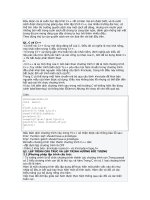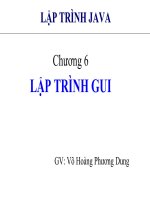Intro to net programming (lập TRÌNH MẠNG cơ bản SLIDE)
Bạn đang xem bản rút gọn của tài liệu. Xem và tải ngay bản đầy đủ của tài liệu tại đây (197.04 KB, 24 trang )
BASIC NETWORK PROGRAMMING
Introduction to Java Network
Programmning
Basic File Operation with File Class
Introduction to Java Network
Programmning
2
Introduction
Computer networking has grown explosively
Since the 1970s, computer communication has
changed from a research topic to an essential
part of infrastructure
Networking is used in every aspect of our lives:
Business
Advertising
Production
Shipping
Planning
Billing
Accounting
Khoa CNTT – ĐH Nông Lâm TP. HCM 08/2010
3/24
Introduction
In short, computer networks are everywhere
In 1980, the Internet was a research project that
involved a few dozen sites
Today, the Internet has grown into a communication
system that reaches all of the world
Internet and WWW have emerged as global
ubiquitous media for communication and changing
the way we conduct science, engineering, and
commerce.
They also changing the way we learn, live, enjoy,
communicate, interact, engage, etc. It appears like
the modern life activities are getting completely
centered around the Internet.
Khoa CNTT – ĐH Nông Lâm TP. HCM 08/2010
4/24
Internet Applications
PC client
Internet
Server
Local Area Network
PD
A
Khoa CNTT – ĐH Nông Lâm TP. HCM 08/2010
5/24
Increased demand for Internet
applications
To take advantage of opportunities presented by
the Internet, businesses are continuously seeking
new and innovative ways and means for offering
their services via the Internet.
This created a huge demand for software
designers with skills to create new Internetenabled applications or migrate existing/legacy
applications on the Internet platform.
Object-oriented Java technologies—Sockets,
threads, RMI, clustering, Web services-- have
emerged as leading solutions for creating
portable, efficient, and maintainable large and
complex Internet applications.
Khoa CNTT – ĐH Nông Lâm TP. HCM 08/2010
6/24
Elements of Client-Server Computing
Re
qu
es
t
a client, a server, and network
Client
Server
Re
Client machine
Network
su
lt
Server machine
Khoa CNTT – ĐH Nông Lâm TP. HCM 08/2010
7/24
Networking Basics
Applications Layer
Standard apps
User apps
Transport Layer
TCP
UDP
Programming Interface:
Sockets
Network Layer
HTTP
FTP
Telnet
TCP/IP Stack
Application
(http,ftp,telnet,…)
Transport
(TCP, UDP,..)
Network
(IP,..)
Link
(device driver,..)
IP
Link Layer
Device drivers
Khoa CNTT – ĐH Nông Lâm TP. HCM 08/2010
8/24
TCP Programming
TCP (Transport Control Protocol) is a
TCP/IP
connection-oriented protocol thatStack
provides a reliable flow of data
Application
between two computers.
(http,ftp,telnet,…)
When two applications want to
communicate to each other reliably,
Transport
they establish a connection and send
(TCP, UDP,..)
data back and forth over that
Network
connection
(IP,..)
TCP provides a point-to-point
Link
channel for applications that require
(device driver,..)
reliable communications.
Example applications:
HTTP
FTP
Telnet
Khoa CNTT – ĐH Nông Lâm TP. HCM 08/2010
9/24
UDP Programming
UDP (User Datagram
Protocol) is a protocol that
sends independent packets
of data, called datagrams,
from one computer to
another with no
guarantees about arrival.
Example applications:
Clock server
Ping
TCP/IP
Stack
Application
(http,ftp,telnet,…)
Transport
(TCP, UDP,..)
Network
(IP,..)
Link
(device driver,..)
Khoa CNTT – ĐH Nông Lâm TP. HCM 08/2010
10/24
Understanding Ports
The TCP and UDP
protocols use ports to
map incoming data to
a particular process
running on a
computer.
app
app
app
app
port
port
port
port
TCP or UDP
Data
server
P
o
r
t
TCP
Client
Packet
port# data
Khoa CNTT – ĐH Nông Lâm TP. HCM 08/2010
11/24
Sockets and Ports
Client
Socket
port 13
Time Service
port 80
Web Service
Socket
Server
Khoa CNTT – ĐH Nông Lâm TP. HCM 08/2010
12/24
Well-Known Ports
20
21
23
25
43
53
80
110
1099
:
:
:
:
:
:
:
:
:
FTP (Data)
FTP
Telnet
SMTP
Whois
DNS
HTTP
POP3
RMI
Khoa CNTT – ĐH Nông Lâm TP. HCM 08/2010
13/24
The World Wide Web
Runs on the Internet
Uses HTTP protocol
Invented by Tim Berners-Lee (and a cast of
thousands)
Khoa CNTT – ĐH Nông Lâm TP. HCM 08/2010
14/24
URL
URL = Unique Resource Locator
protocol://host[:port][/path/][file][#anchor]
/> /> />
Khoa CNTT – ĐH Nông Lâm TP. HCM 08/2010
15/24
HTTP
port 80 default
Client:
GET path HTTP/1.0
Header: value
blank line
Server:
HTTP/1.0 OK 200
Header: value
blank line
data
telnet demo again
Khoa CNTT – ĐH Nông Lâm TP. HCM 08/2010
16/24
Basic File Operation with File
class
17
The java.io.File Class
An abstract representation of file and directory
pathnames.
For UNIX platforms, the prefix of an absolute pathname
is always "/". Relative pathnames have no prefix.
For Microsoft Windows platforms, the prefix of a
pathname that contains a drive specifier consists of the
drive letter followed by ":" and possibly followed by "\\"
if the pathname is absolute (D:\\myfolder\\t.txt). A
relative pathname that does not specify a drive has no
prefix.
public File(File parent, String child)
Creates a new File instance from a parent abstract
pathname and a child pathname string.
public File(String parent, String child)
Creates a new File instance from a parent pathname
string and a child pathname string.
Khoa CNTT – ĐH Nông Lâm TP. HCM 08/2010
18/24
The java.io.File Class
public File(String pathname)
Creates a new File instance by converting the given
pathname string into an abstract pathname. If the
given string is the empty string, then the result is the
empty abstract pathname.
public String getPath()
Converts this abstract pathname into a pathname
string.
public boolean isAbsolute()
Tests whether this abstract pathname is absolute.
public String getCanonicalPath ()
Returns the absolute and unique pathname string of
this abstract pathname.
public boolean canRead()
Tests whether the application can read the file
denoted by this abstract pathname.
Khoa CNTT – ĐH Nông Lâm TP. HCM 08/2010
19/24
The java.io.File Class
public boolean canWrite()
Tests whether the application can modify the file
denoted by this abstract pathname
public boolean exists()
Tests whether the file or directory denoted by this
abstract pathname exists.
public boolean isDirectory()
Tests whether the file denoted by this abstract
pathname is a directory.
public boolean isFile()
Tests whether the file denoted by this abstract
pathname is a normal file.
public boolean isHidden()
Tests whether the file named by this abstract
pathname is a hidden file.
Khoa CNTT – ĐH Nông Lâm TP. HCM 08/2010
20/24
The java.io.File Class
public long length()
Returns the length (the zise in Kbyte) of the file
denoted by this abstract pathname.
public boolean delete()
Deletes the file or directory denoted by this abstract
pathname. If this pathname denotes a directory, then
the directory must be empty in order to be deleted.
public String[] list()
Returns an array of strings naming the files and
directories in the directory denoted by this abstract
pathname.
public String[] list(FilenameFilter filter)
Returns an array of strings naming the files and
directories in the directory denoted by this abstract
pathname that satisfy the specified filter.If the given
filter is null then all names are accepted.
Khoa CNTT – ĐH Nông Lâm TP. HCM 08/2010
21/24
The java.io.File Class
public File[] listFiles()
Returns an array of abstract pathnames denoting the
files in the directory denoted by this abstract
pathname.
public File[] listFiles(FilenameFilter filter)
Returns an array of abstract pathnames denoting the
files and directories in the directory denoted by this
abstract pathname that satisfy the specified filter.
public boolean mkdir()
Creates the directory named by this abstract
pathname.
public boolean mkdirs()
Creates the directory named by this abstract
pathname, including any necessary but nonexistent
parent directories.
Khoa CNTT – ĐH Nông Lâm TP. HCM 08/2010
22/24
The java.io.File Class
//List of all files in D: with extention tgz
import java.io.*;
import java.util.*;
public class DLister {
public static void main(String[] args) {
File path = new File("D:\\");
String[] list;
list = path.list(new DirFilter(".tgz"));
for(int i = 0; i < list.length; i++)
System.out.println(list[i]);
}}
class DirFilter implements FilenameFilter {
String afn;
DirFilter(String afn) { this.afn = afn; }
public boolean accept(File dir, String name) {
String f = new File(name).getName();
return f.indexOf(afn) != -1;
}}
Khoa CNTT – ĐH Nông Lâm TP. HCM 08/2010
23/24
Exercise
public boolean deleteDir(String path)
public boolean find(String path, String
filePattern)
public boolean find(String path, String pattern)
Khoa CNTT – ĐH Nông Lâm TP. HCM 08/2010
24/24









